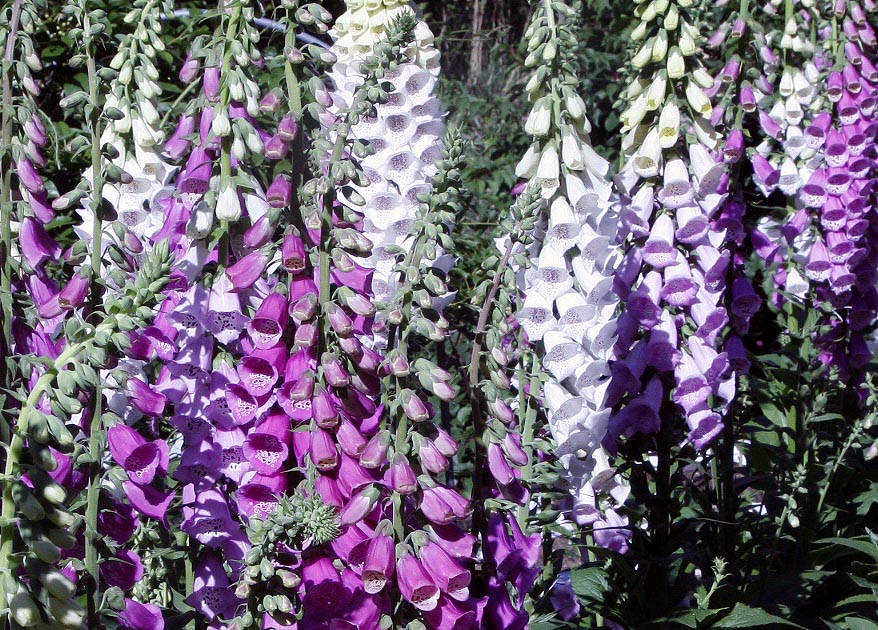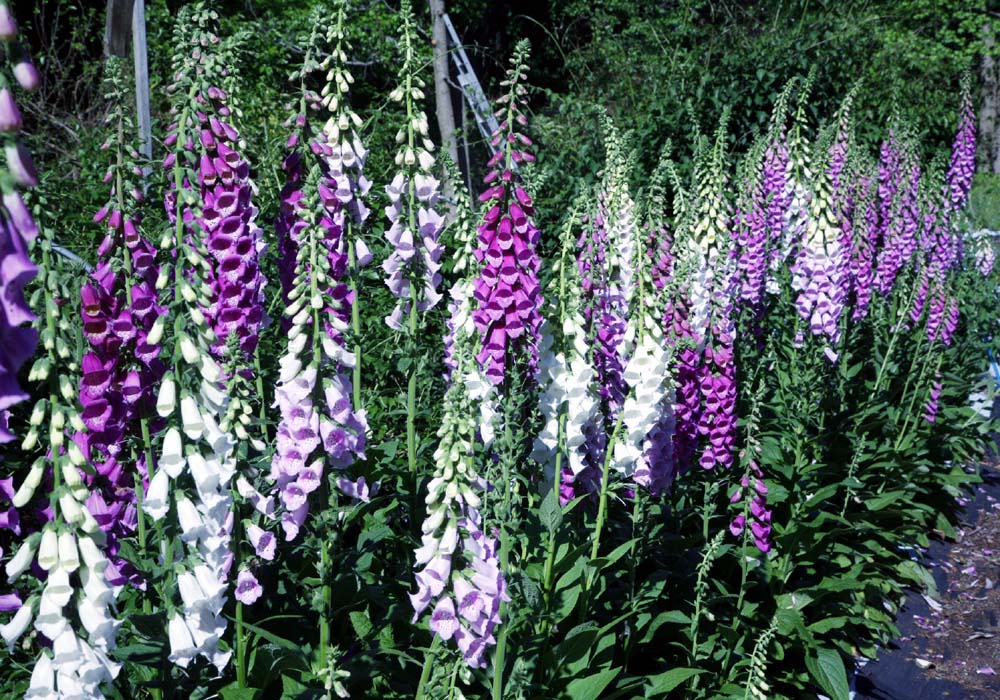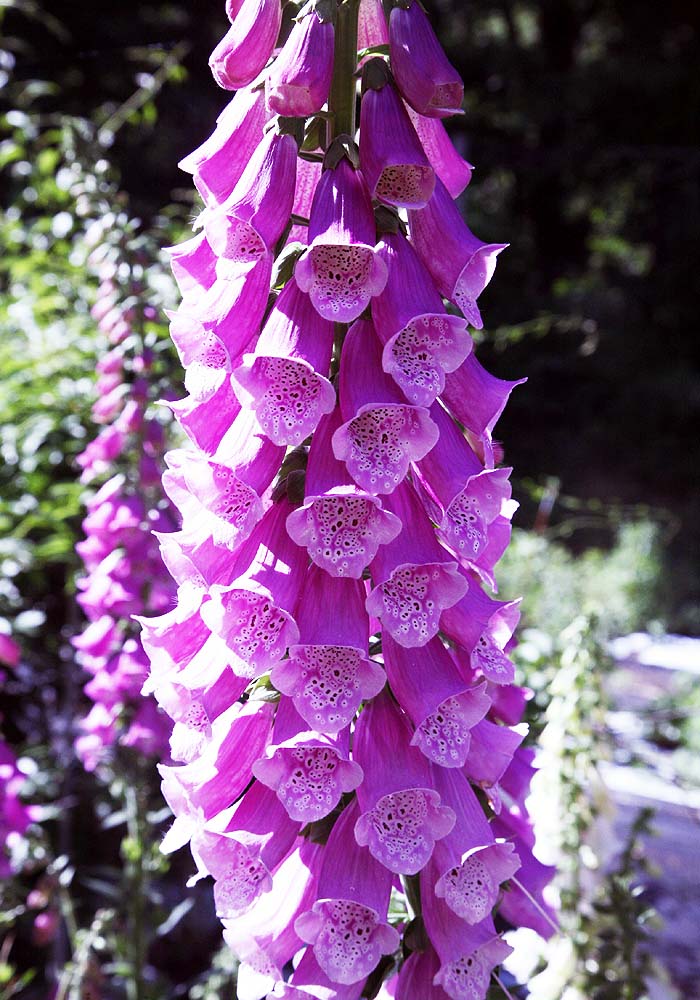Beautiful dramatic tall biennial that sometimes acts like a short lived perennial. Hardy to zone 4. Flower spiked can reach 6 feet (1.8m) in height and will flower for about 2 months from early summer onwards. Very easy to grow, flowers in the second year from seed, needs good sunshine and regular water. Not fussy about soil type provided it is well drained but will not grow tall unless has a good amount of organic material, then may only reach 3 feet (1m). Ideal for back borders or growing for cut flower use. Wildlife dont eat it.
Warning. This plant is poisonous and should not be grow in gardens where small children or pets will be playing. Can cause death if ingested.
In spring of the second year tall circular stems arise that can reach 6 feet (1.8m) or more in good conditions. The lower sections have small versions of the basal leaves arranged in alternate pairs along the stem but the top half has a spectacular flower head. Individual blooms begin at the base of the flower stalk progressing upwards and can last for two or more months. Each flower is a bell shaped tube with four subtle lobes with the base of the flower being the largest and downward facing while the other three flare out around the end of he tube. Flowers can be purple, pink or white in color. The inside base of the tube is speckled with darker marking usually dark purple surrounded by white or light pink in a 'crazy paving' like pattern leading into the flower and the stamens that are located deep in the tube. The lower section of the flower acts as a landing platform so visiting bees can then scramble inside to reach the rich source of nectar and pollen within. Each flower can be up to 2.5 inches (6cm) long and are arranged in staggered wholes around the stem although most stalks seem to have a 'back' on the north side of the flower stalk where there are less blooms. Flower stalks can hold up to 80 individual blooms.
While most plants produce one main flower spike the may produce smaller stems if conditions are good and if stems are cut down after flowering has completed if light and temperature conditions are right, usually below zone 5b they may produce a second flower spike to flower up until the frost comes.
Each flower is followed by a small rounded capsule that turns brown on maturity and splits open to release large numbers of small seeds. These can self seed easily in good conditions.
Use a good well draining compost and keep moist. usually germinate in 7-14 days with temperatures around 70 F (21C). grow on and transplant to individual pots until about three inches tall then after danger of frost has passed they can be transplanted out. keep moist until established.
Light. In zones 4-6b full sun almost all day is ideal and most locations. In zone 7 -8a shade from the noon sun in an area where it can receive breezes would be best. In 8b and warmer light shade in areas with a breeze are required.
Foxgloves are originally from Europe where they are commonly found in open settings along streams, cliffs and woodland edges, they are not adapted to hotter climates and will need protection from bright sun if grown in these zones.
In cooler zones they are very tough and can give amazing displays in cool zones where its hard to get showy displays.
Soil. Foxgloves grow best in good soils with lots of organic material. They can then grow to 6 feet (m) or more in height. however they will grow in most soils provided they are well drained, they don't like waterlogged soils. In poorer soils they may only reach 3 feet (1m) in height.
Water. Needs a moist soil, this plant is not drought tolerant and may die back if not enough water. Keep soil moist watering a few times a week depending on rainfall.
Make great back border plants of for areas where height is required sown in a group they can make very dramatic displays that last for a couple of months.
Plants may need staking if they become tall and are located in areas where breezes have not toughened stems sufficiently to keep them upright. In most locations with enough breeze they manage well by themselves but if intermittent strong winds are likely such as violent thunderstorms staking may be necessary.
Warning. using Digitalis to treat heart issues can be dangerous as the therapeutic dose is very close to the lethal dose. Since plants are variable it is not easy to determine the exact amount of digoxin contained in any plant so dosage is hard to determine. Pharmaceutical drugs have been standardized to provide a specific amount of digoxin in a dose so it is easy to determine how much is given and at what interval. Foxglove leaves should not be used unless by a very experienced herbalist who is able to test the plants beforehand.
The tall spikes can add lots of drama and interest to flower arrangements. White ones are really lovely for wedding displays.
An apple green dye can be made from the flowers. It is also reported that growing foxgloves near a root cellar helps them to store better.








